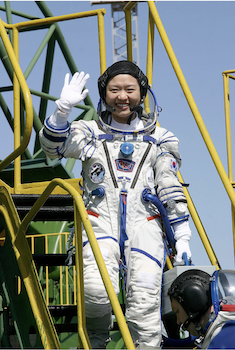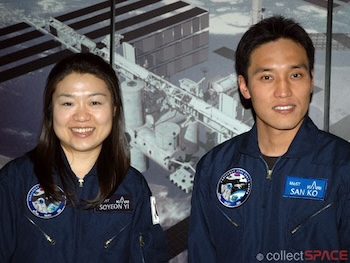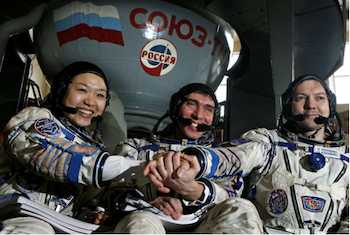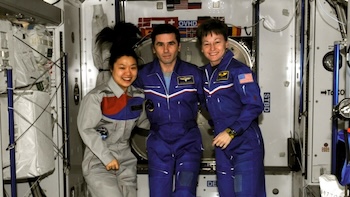
Yi Soyeon, born on June 2, 1978, in Gwangju, South Korea, grew up in a modest farming town in South Korea with her father, Yi Gil-soo, and mother, Jeong Geum-soo. Despite their financial struggles, her childhood was filled with happiness. However, there was pervasive gender discrimination in her community: women were barred from education and prohibited from learning to read and write. Therefore, these apparent gender expectations profoundly impacted Soyeon because no women in her mother’s generation were able to receive an education. As time progressed, Soyeon was fortunate to receive an education that she embraced wholeheartedly, and therefore, she was able to develop a love for science and engineering.
Her father’s influence was pivotal in deepening and nurturing Soyeon’s passion for STEM. In a household where money for repairs was scarce, Soyeon often assisted her father with fixing machines, sparking her interest in mechanical processes and problem-solving from an early age.

By middle school, Yi Soyeon had distinguished herself as a gifted student, academically excelling in her studies. Because of this, the South Korean education system’s provision for gifted programs allowed her to apply, and after passing a rigorous exam, Soyeon was admitted to Gwangju Science High School: a prestigious science high school specializing in engineering and science.
By the time she completed high school, Soyeon had become the first woman in her family to pursue education beyond middle school, breaking entrenched generational barriers in education for her family. Despite her evident intelligence and talent, she faced disappointment due to college rejections, unlike many of her peers. Nevertheless, undeterred by this apparent hardship, a year later she secured a spot at the prestigious Korea Advanced Institute of Science and Technology (KAIST). Attending one of the most reputable colleges in the country, she earned a bachelor’s and master’s degree in mechanical engineering and received a PhD in biosystems. Furthermore, Soyeon thrived academically, seizing numerous academic opportunities for intellectual growth. Specifically, she interned at the Korean Institute of Machinery and Materials for photo research and development, enabling her to collaborate with many of the top scientists at prominent technology brands, including Samsung and LG. However, being the sole woman working with a cohort of many men, Soyeon often grappled with feelings of self-doubt, questioning her intelligence and future success in comparison to her male counterparts.

Throughout her journey as a PhD student, Soyeon was frequently subjected to discrimination and cruel remarks from her male peers, solely based on her gender. Especially in a workplace where the majority of the researchers were older men, Soyeon frequently encountered derogatory remarks from her male peers, who openly expressed a preference for working with male researchers. A particularly horrible incident occurred when a colleague during a phone call bluntly stated, “I want to talk to the researcher, not the secretary”, highlighting the pervasive sexism Soyeon faced. By the time she was 24, she had her first presentation on biosystems research in Japan. Despite being the youngest and only female presenter among representatives from 30 to 40 countries, she felt happy for the opportunity to “stand out.” Reflecting on this experience, she remarked, “...it felt like a challenge, but I realized people were excited to see me. Everyone noticed my career and my work. It made me feel unique.” - (Yi Soyeon)
As a PhD student, Soyeon decided to pursue her childhood dream of space travel by applying to the Korean Astronaut Program after reading about it in the newspaper. At the time, Korea, along with several other nations, had recently inaugurated its astronaut program. The minister of science and technology in Korea made an exception for one astronaut from Korea to go to the International Space Station. Determined to fulfill her childhood aspiration of “taking a train to space”, Soyeon applied after meeting all the criteria. Remarkably, she became one of the two finalists out of 36,000 applicants. Despite facing skepticism and criticism from some of her peers, many others supported and cheered her on as she pursued her dream.

After she was accepted, Soyeon trained in Russia for a year as the backup to computer engineer Ko San, who initially was supposed to be the one Korean astronaut who went on the flight. Training on a Russian military base was initially a culture shock for her, but Soyeon quickly adapted. Even as a backup crew member, she underwent rigorous training, mastering the intricacies of space flight, rockets, zero-gravity environments, and participated in numerous simulations.
However, on March 7, 2008, a month before the launch, Ko San, the original Korean astronaut, was banned from the mission for allegedly violating security protocol by sending secret information to South Korea. Suddenly, Soyeon was promoted to the primary astronaut role and was scheduled to join the launch only a month later. Contrary to what many might expect, Soyeon did not have the time to be frightened by this sudden change. In an interview, she explained that her focus was on ensuring everything was perfect for the flight, leaving no room for fear.

On April 8, 2008, Yi Soyeon launched into space after boarding Soyuz TMA-12 with two Russian cosmonauts, Sergey Volkov and Oleg Kononenko, on April 8, 2008. Throughout the 11-day mission, Soyeon completed 18 experiments and conducted various medical tests, interviews, and discussions. Her experiments included studying the effects of fruit flies in space, growing plants in space, gravitational changes on her physiology, and the behavior of her heart in microgravity. Although the mission was a success, it faced a critical challenge when the equipment failed to separate properly, leading to a rough landing that resulted in back injuries requiring hospitalization for Soyeon. She would later discover that she nearly escaped death coming back to Earth.
Following her historic mission, Soyeon continued to work as a researcher at the Korea Aerospace Research Institute with Ko San and furthered her studies at various space programs. Eventually, Soyeon decided to resign from the space program for several personal reasons including her marriage to Jason J. Chung and her desire to pursue an MBA. Soyeon obtained her MBA at the University of California, Berkeley Haas School of Business in May 2014. She now resides in Seattle, working at Noul Co., Ltd, a biotechnology startup.
Soyeon’s journey as a minority in STEM, marked by significant discrimination, has shattered numerous stereotypes and demonstrated that women can indeed follow their passions and excel in traditionally male-dominated fields. In an interview, she offered a powerful perspective: “The fact that I'm a woman is my greatest advantage, because it makes me work so much harder. Even when I know I am being discriminated against, I try not to think of myself that way, work harder, and work the situation to my advantage.” Soyeon’s story illustrates that with unwavering dedication and resilience, any dream is truly attainable. Her pioneering spirit continues to inspire and pave the way for future generations of women to excel in the STEM fields. Yi Soyeon’s legacy is a testament to the transformative power of education and the profound impact of tenacity. Her story is a message for women to pursue their ambitions relentlessly and to view challenges as opportunities for growth.
Why Did I Choose to Research Yi Soyeon?
Growing up in a family of strong Korean women, Yi Soyeon’s story resonated with me profoundly. I chose to research Soyeon because her story is truly a representation of resilience and determination. It is astonishing how she was not initially chosen to be the first Korean astronaut, yet fate led her to fulfill the role. I wrote about her story to inspire others to persevere amidst various challenges and to remind others to believe in their own potential.
Works Cited
Bruestle , S. (2019, November 17). Korea’s first and only astronaut shares her story in Stanwood. heardnet.com. Retrieved September 3, 2022, from https://www.heraldnet.com/life/koreas-first-and-only-astronaut-shares-her-story-in-stanwood/
Britannica (2020). Yi Soyeon. Britannica.com. Retrieved September 3, 2022, from https://www.britannica.com/biography/Yi-Soyeon
Rudolph, H. (2016, January 11). Get That Life: How I Became Korea's First Woman Astronaut. cosmopolitan.com. Retrieved September 3, 2022, from https://www.cosmopolitan.com/career/interviews/a51443/soyeon-yi-get-that-life-koreas-first-woman-astroanaut/
The Sky , H. (2020). Feature Female Friday: Soyeon Yi. halftheskyasia.com. Retrieved September 3, 2022, from https://www.halftheskyasia.com/blog/2019/05/feature-female-friday
This article was published on 7/26/24